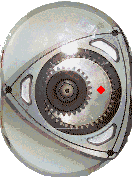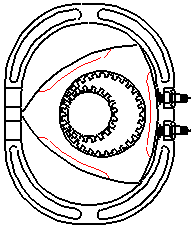|
|
Rotary Engine

The aim is to substitute the strong acceleration or deceleration of the stroke piston through an even rotary movement of the rotor, thus achieving higher RPM and above all, smooth running with little vibrations.
An eccentric shaft leads a rotor with three edges and slightly outward-curved flanks into a casing in such a way that each edge has contact with the casing wall. On the top left of the casing is the exhaust port, on the
bottom left, the intake port, on the right are one or two spark plugs.
A full rotation of the shaft causes only 1/3 of a rotation of the rotor. The casing, rotor and eccentric shaft together, provide, on each flank, for an increase or reduction of the space between the rotor-flank and the casing-wall.
Thereby, with the one flank mixture is taken in, with the next it is compressed or ignited and with the third the exhaust gas is expelled. The rotary piston engine is also called 'the Wankel engine', after it's inventor, Felix
Wankel.

The above figure shows the rotor with it's piston-hollows, the water-cooled casing and the two spark plugs. Although in the first realisations of this engine at NSU, there were problems with the wear and tear on the
sealing strips, one can in the meantime, safely say that through further development at Mazda, the problems have been solved. What remains however, is the unfavourable, long combustion chamber, which doesn't
help either the exhaust gases nor the fuel consumption. The plans, to use the engine, with constant RPM, as a range-extender, have also, e.g., at Audi, been put back on the shelf. There are still the diehards, who
dream about catching up with the petrol engine by using layer-charging. 10/12
|
|